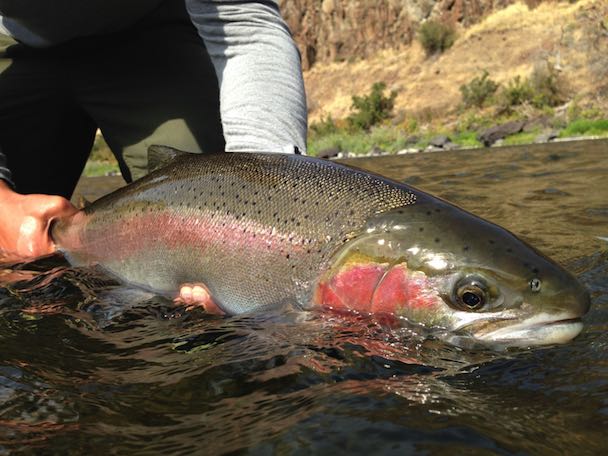forum
library
tutorial
contact

Hatchery Steelhead Targeted in Bag Limit
Changes on Snake River Tributaries
by Staff
Columbia Basin Bulletin, January 26, 2018
|
the film forum library tutorial contact |

|
Hatchery Steelhead Targeted in Bag Limit
by Staff
|
 Anglers fishing the Snake River and some of its tributaries in Oregon, Washington and Idaho can keep two to three steelhead per day until further notice.
Anglers fishing the Snake River and some of its tributaries in Oregon, Washington and Idaho can keep two to three steelhead per day until further notice.
Due to a historically low Columbia River steelhead run, daily bag limits had been reduced or eliminated in the summer and fall due to conservation measures adopted by fisheries managers in the three states. The protections were through a series of temporary regulations designed to protect wild steelhead and also to ensure hatchery returns would fill quotas at upriver hatcheries.
Anticipating the poor run and to reduce the harvest of both hatchery and wild steelhead, Oregon and Washington earlier in the summer set area-specific, 1-2 month steelhead retention closures, including rolling closures that progress upriver following the steelhead return.
In Oregon, the steelhead season on Snake River tributaries began Sept. 1, 2017 with a one-fish daily limit, along with catch and release only on the Snake River. They were increased to two fish per day Oct. 21 in the Snake River and tributaries after forecasted returns of summer steelhead exceeded biologists' expectations. However, those temporary regulations expired at the end of 2017, which is when the permanent bag limit -- three steelhead per day in Oregon -- was reinstated.
Washington had also made the summer and fall reductions to bag limits in order to protect both A-run (steelhead smaller than 28 inches) and B-run fish destined for the Snake and Columbia river basins.
"However, A-run steelhead, both wild and hatchery-origin adults, have returned in adequate numbers to allow opening portions of the Snake River to steelhead retention, including the lower portion of the river," the Washington Department of Fish and Wildlife said in a news release Nov. 16, 2017. Anglers are allowed to keep two A-run fish in the lower Snake River in Washington.
Allowing retention of fish measuring less than 28 inches in length will give anglers the opportunity to harvest excess hatchery A-run steelhead, while still providing protection to the remaining B-run steelhead within this reach, WDFW said.
Citing similar reasoning, the Idaho Department of Fish and Game, beginning Jan. 1, also set the steelhead bag limit at two fish per day on the Snake River and six fish statewide. Like Oregon and Washington only hatchery fish (adipose fins are clipped) may be harvested and only A-run fish can be harvested in the Clearwater River basin or on the Snake River from the confluence at Lewiston upstream to Couse Creek Boat Ramp, according to a Dec. 22, 2017 IDFG news release.
An updated brochure is available on IDFG's Steelhead Fishing Rules page.
Fisheries managers in each of the states relaxed bag limits after determining that more than enough fish were returning to rivers to support hatchery programs.
ODFW district biologist in Enterprise, Jeff Yanke, attributed the change to conservative management of the steelhead stock earlier when retention was limited or curtailed.
"We made justified decisions last fall to reduce harvest in the mainstem Columbia and Snake rivers, including the tributaries," Yanke said. "As designed, that allowed more steelhead to escape harvest and return to natal rivers."
Typically, about 65 percent of Oregon bound Snake River steelhead that pass Bonneville Dam make it to the Snake River, but this year some 70 percent survived the journey, he said. He estimated about 1,500 Grand Ronde River and 800 Imnaha River steelhead will be surplus to production needs.
"Unharvested hatchery steelhead can miss their intended destination at hatchery facilities, straying into nearby streams and spawning with wild steelhead," he said. "Harvest is a tool we use to reduce that risk while achieving the harvest objectives of our programs."
Oregon cautions anglers when handling wild steelhead to catch and release them with care. "Wild steelhead populations, like their hatchery cousins, are also returning at very low levels," Yanke said. "This year, more than most others, each fish counts for the future."
Washington opened Nov. 16, 2017 and until further notice the Snake River from the mouth of the river (Burbank to Pasco railroad bridge at Snake River mile 1.25) to the Washington/Idaho state line, at Clarkston Wash. with a daily limit of two hatchery steelhead under 28 inches. Only barbless hooks are allowed.
Already open for two hatchery fish under 28 inches was the Snake River from the Idaho/Washington state line (at Clarkston, Wash.) upstream to the Couse Creek Boat Ramp and the Snake River from Couse Creek Boat Ramp upstream to the Idaho/Oregon state line.
Related Sites:
Idaho Opens Rivers For Steelhead Fishing With Restrictions; Says Rules Will Protect Wild Fish by Staff, Columbia Basin Bulletin 10/20/17
Washington Opens Sections Of Snake River To Steelhead Retention For Fish Under 28 Inches by Staff, Columbia Basin Bulletin 10/13/17
Idaho Seeks Public Comment On Reopening Steelhead Angling For Hatchery Fish Under 28 Inches by Staff, Columbia Basin Bulletin 10/6/17
Record Low Steelhead Run Spurs Closures, Reduced Bag Limits; Return Only 30 Percent Of Average by Staff, Columbia Basin Bulletin 8/1/17
Fall Commercial Fishing Begins On Columbia, Low Steelhead Numbers Prompts Idaho To Suspend Retention by Staff, Columbia Basin Bulletin 8/25/17
Fall Fishing Opens To Lower Than Usual Chinook Returns; Season Includes Rolling Steelhead Closure
learn more on topics covered in the film
see the video
read the script
learn the songs
discussion forum
